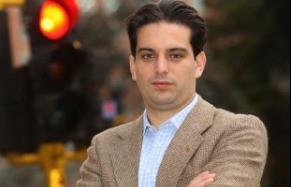Colombia-Venezuela Relations: What Are the Prospects?
Colombia and Venezuela have a history of rocky relations characterized by short bursts of improvement and deterioration.
With no time to lose, Colombia’s newly appointed Director of National Planning Simón Gaviria Muñoz has gotten to work on an ambitious agenda. Appointed by President Santos earlier this month, Gaviria joined the Dialogue for a stimulating conversation on the direction of Santos’ second-term on Friday, September 19th.
Formerly the head of Colombia’s Liberal party, Gaviria is now charged with coordinating among ministries, creating policies to carry out government priorities, and budgeting at the national level for the next five years. Furthermore, as part of Santos’ new “peace” cabinet, Gaviria must set the stage for implementing peace in a post-conflict scenario, should a peace agreement be signed between the Colombian government and the FARC, the country’s largest guerilla group. Gaviria opened his presentation by reiterating the three main points of Santos’ inaugural address that he will strategically address in his National Development Plan: 1) constructing peace, 2) improving equality, and 3) advancing education. Gaviria spoke of innovation and execution as the keys to successfully implementing this bold agenda.
Gaviria began by commenting on GDP figures released last week, noting that all-in-all the figures are “very, very positive” and currently position Colombia as the fastest growing country in the region. He attributed such growth to Colombia’s new mining and oil royalties’ scheme, which aims to distribute incomes more equitably across Colombia’s regions. Additionally, Gaviria highlighted commerce, tourism, and the financial services sectors as driving growth, while citing the agriculture, industry, and mining and energy sectors as areas of concern. In keeping with Santos’ second-term vision, Gaviria sees a strong economy as the means to reducing poverty in Colombia to less than 20% by the end of the decade while also drastically improving equality.
Gaviria also spoke of the administration’s peace agenda, noting that the President wants to push forward two types of peace: first, a peace with the guerillas, and second, a peace with the country, in particular with those areas that have suffered the effects of a decades-long armed conflict. “The encompassing concept behind these two types of peace is closing the gap between urban, modern growth and rural areas that need to be incorporated into that engine of growth,” he noted.
A lively question and answer period followed Gaviria’s presentation and covered a broad range of topics, from foreign investment to decentralization to climate change. Gaviria seized this opportunity to highlight the Colombian government’s progress on several fronts, including headway on a proposed subway system for Bogotá as well as the proud announcement that “for the first time in Colombia’s history, the investment component of our education budget is higher than the investment component in our defense budget.”
Gaviria concluded by challenging US policymakers to consider the role that they might play in Colombia’s post-conflict scenario. “I think the US should start having a debate about how it is going to engage with Colombia and help in its transition period,” he said, ending the discussion while also prompting a new debate.
Colombia and Venezuela have a history of rocky relations characterized by short bursts of improvement and deterioration.
On August 7, an important chapter in Colombian-Venezuelan relations that has coincided with the presidencies of Alvaro Uribe and Hugo Chavez will come to an end. These last eight years have been a rollercoaster, with moments of great tension but also occasional pragmatism.
While Santos is familiar with Chávez’s unpredictability and knows as well as anyone where the FARC rebels are and what they are up to, he also knows the economic stakes for Colombia.
